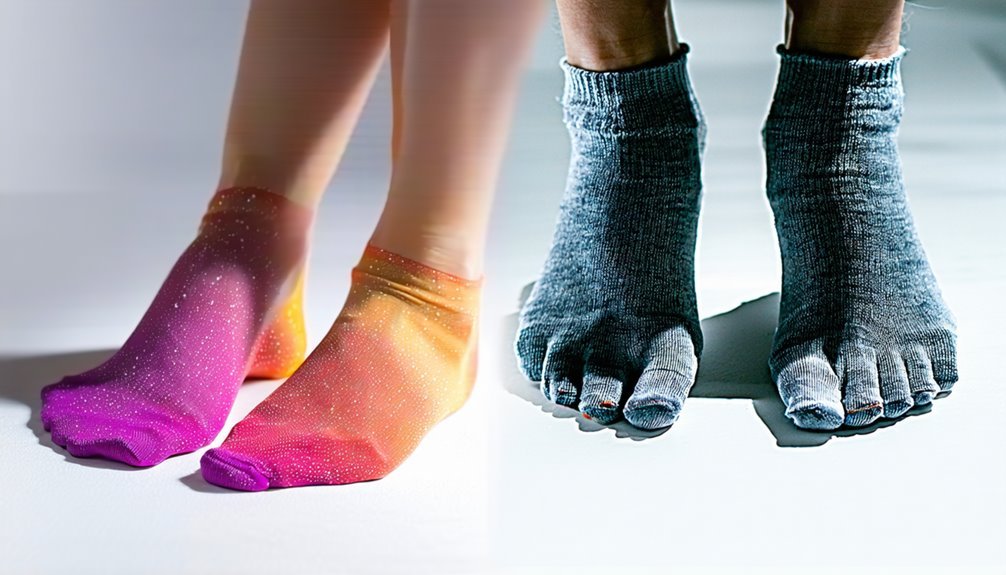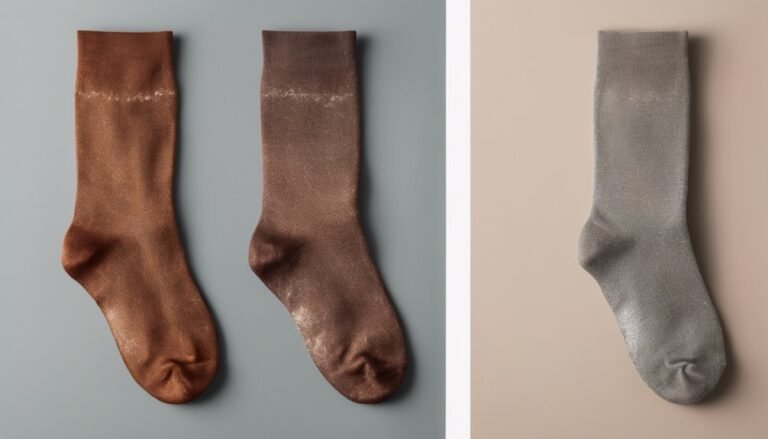Polyester Socks Vs Cotton
When choosing between polyester and cotton socks, consider material properties. Polyester, with superior fiber strength and moisture-wicking capabilities, offers durability, shape retention, and quick drying. Cotton provides natural softness, hypoallergenic comfort, and better breathability, although it retains moisture longer. Polyester's synthetic structure is less breathable but more cost-effective, while cotton boasts eco-friendliness due to biodegradability. Think about application, durability, comfort, and environmental impact to guide your decision. Consider exploring further to make a more informed choice.
Durability and Longevity

When evaluating the durability and longevity of polyester versus cotton socks, material properties play a significant role in performance. Polyester socks benefit from superior fiber strength, making them less prone to tears and structural deformation under stress. Their synthetic fibers are engineered to exhibit high wear resistance, which is vital for maintaining sock integrity during repeated use. In contrast, cotton fibers, while breathable and soft, lack the same tensile strength and tend to wear out faster under rigorous conditions.
For those prioritizing safety, the enhanced durability of polyester means reduced risk of unexpected sock failure during critical activities. Polyester's robust construction guarantees that the socks maintain their shape and function over time, offering reliable protection and comfort. This resilience is important for long-term use, minimizing replacement frequency.
Moisture-Wicking Capabilities
When considering moisture-wicking capabilities, polyester's hydrophobic nature allows it to effectively transport moisture away from the skin, facilitating rapid evaporation. In contrast, cotton's hydrophilic fibers absorb and retain moisture, which can lead to prolonged dampness. You'll find that polyester excels in quick drying, making it ideal for high-intensity activities, whereas cotton's absorption properties might be more suitable for low-sweat environments.
Polyester's Quick Drying
Polyester's moisture-wicking capabilities are a standout feature, particularly due to its synthetic structure that facilitates quick drying. When you wear polyester socks, you're tapping into the quick drying benefits that come from its hydrophobic nature. This characteristic propels moisture away from the skin, reducing drying time and lowering the risk of fungal infections and blisters. The table below highlights key differences:
| Feature | Polyester Socks |
|---|---|
| Structure | Synthetic, hydrophobic |
| Quick Drying Benefits | High moisture evaporation |
| Drying Time Comparison | Typically faster |
| Safety | Reduces moisture-related risks |
Polyester's fibers don't absorb water, allowing air to circulate and moisture to evaporate swiftly. This quick drying capability guarantees your feet remain comfortable and safe, especially in strenuous or humid conditions. Choosing polyester socks can be a strategic decision for enhancing foot health and comfort.
Cotton's Absorption Properties
Although polyester is known for its quick-drying capabilities, cotton offers a different approach with its absorption properties. Cotton fibers excel in absorption efficiency, drawing moisture away from your skin and into the fabric. This occurs due to the hygroscopic nature of cotton, which allows it to hold up to 27 times its weight in water. In fabric comparison, cotton's substantial absorption can provide a sense of dryness and comfort, vital for safety in maintaining skin health.
With moisture-wicking capabilities, cotton acts as a natural buffer, reducing friction and potential skin irritation. It's essential to recognize that while cotton is less effective in evaporating moisture than polyester, its ability to absorb can prevent sweat accumulation, enhancing your overall comfort and safety in various environments.
Comfort and Softness

The tactile experience of socks greatly impacts comfort and softness, with material composition playing an essential role. When evaluating softness comparison, cotton fibers provide a natural texture, often perceived as softer against the skin. This softness is attributed to cotton's inherent cellulose structure, which offers a plush feel. However, polyester, synthesized from petrochemicals, boasts a smoother, silkier finish due to its refined polymer chains.
In terms of comfort levels, cotton's hypoallergenic properties make it suitable for sensitive skin, reducing irritation risks. Polyester, though less absorbent, offers consistent elasticity and shape retention, which can enhance fit and prevent slippage. For safety-conscious individuals, both materials have their merits; cotton prioritizes gentleness, while polyester guarantees durability and structural integrity. Your choice should align with your comfort priorities.
Breathability and Temperature Regulation
When considering breathability and temperature regulation in socks, material properties are critical. Cotton fibers are naturally breathable, allowing for superior airflow efficiency. This guarantees excess heat dissipates, reducing heat retention and maintaining a comfortable foot environment. Cotton's moisture-wicking capacity also enhances cooling, which is crucial for prolonged wear and safety. Conversely, polyester's synthetic structure offers less breathability, potentially increasing heat retention. However, advancements in polyester blends have improved airflow efficiency, though not on par with cotton. This may lead to hotter feet in high temperatures, which could compromise comfort and safety. Choosing socks with ideal breathability and temperature regulation is important to prevent overheating and maintain foot health, especially during extended physical activities or in warm conditions.
Maintenance and Care
When considering washing instructions, you'll find that polyester socks generally exhibit greater resistance to high temperatures and frequent laundering compared to cotton, which can degrade and lose elasticity over time. Polyester's synthetic fibers maintain structural integrity, contributing to enhanced durability and longevity, while cotton fibers are prone to wear and may require more careful handling to preserve their quality. Understanding these material properties guarantees you can optimize the lifespan of your socks by adhering to proper maintenance protocols.
Washing Instructions
Ensuring the longevity of your polyester and cotton socks involves understanding their distinct washing requirements, each tailored to their material properties. Polyester socks benefit from washing techniques involving cold water and a gentle cycle, minimizing the risk of heat-induced fiber damage. Avoid fabric softeners, as they can impede moisture-wicking capabilities. Conversely, cotton socks thrive under warm water conditions, effectively removing oils and bacteria. A mild detergent is recommended for cotton to preserve fiber integrity. In fabric care, always separate colors to prevent dye transfer. For both materials, air-drying is preferable to tumble drying, reducing shrinkage and fabric wear. By adhering to these guidelines, you'll maintain your socks' structural and aesthetic qualities, ensuring hygienic and safe wearing experiences.
Durability and Longevity
Though often overlooked, the durability and longevity of socks are vital factors influenced by their material composition and care regimen. Polyester socks exhibit superior wear resistance due to their synthetic fibers, which resist abrasion and maintain structural integrity over time. This quality guarantees that they withstand repeated use without significant deterioration, offering a safer option for those concerned with maintaining foot protection.
In contrast, cotton socks, while comfortable, are prone to wear and tear due to their natural fibers, which may degrade more quickly. Proper care, such as gentle washing, can mitigate this, but their environmental impact is notable; cotton production involves significant water and pesticide use. Polyester, despite its durability, poses environmental challenges due to its non-biodegradable nature. Balancing these factors is vital for informed decision-making.
Cost and Affordability
Considering the cost and affordability of polyester versus cotton socks, it's important to evaluate their material properties and production processes. Polyester, synthesized from petrochemicals, typically involves a less expensive manufacturing process compared to cotton, which requires agricultural cultivation. This factor often makes polyester socks more economical, ideal for budget considerations. Conversely, cotton, a natural fiber, may incur higher production costs, impacting price comparison.
When deciding on which socks are more cost-effective, consider:
- Production cost: Polyester's synthetic nature generally means lower costs.
- Durability: Long-lasting polyester can provide better value over time.
- Comfort: Cotton offers a softer feel, though at a premium price.
- Moisture-wicking: Polyester excels, reducing the need for frequent replacements.
- Environmental impact: Cotton is biodegradable, influencing long-term environmental costs.
Frequently Asked Questions
How Do Polyester and Cotton Socks Impact Foot Odor?
You're concerned about foot odor, right? Cotton's poor moisture management can lead to odor retention, while polyester's superior properties reduce this risk. Polyester effectively wicks moisture away, decreasing bacterial growth and promoting safety in foot hygiene.
Are Polyester Socks Suitable for People With Allergies?
When considering if polyester socks are suitable for those with allergies, it's essential to assess potential allergy reactions due to synthetic fibers. Polyester's material properties might not be ideal for skin sensitivity, unlike hypoallergenic alternatives. Prioritize safety.
Do Polyester Socks Contribute to Static Electricity?
Ever considered how sock materials affect static charge? Polyester, due to its synthetic nature, can indeed increase static electricity. It's because polyester fibers generate friction, unlike natural fibers. For safety, opt for materials with lower static potential.
Can Cotton Socks Be Dyed More Easily Than Polyester?
You'll find cotton socks offer superior dye absorption and colorfastness due to their natural fibers. This guarantees even, long-lasting color without harmful chemicals, prioritizing your safety while providing vibrant, reliable results unmatched by synthetic materials.
How Do Polyester and Cotton Socks Affect the Environment?
When considering sustainable sourcing, polyester's synthetic nature often means less biodegradability compared to cotton's natural, biodegradable materials. Cotton's environmentally friendly properties, however, depend on responsible farming practices to guarantee minimal ecological impact and prioritize safety.







